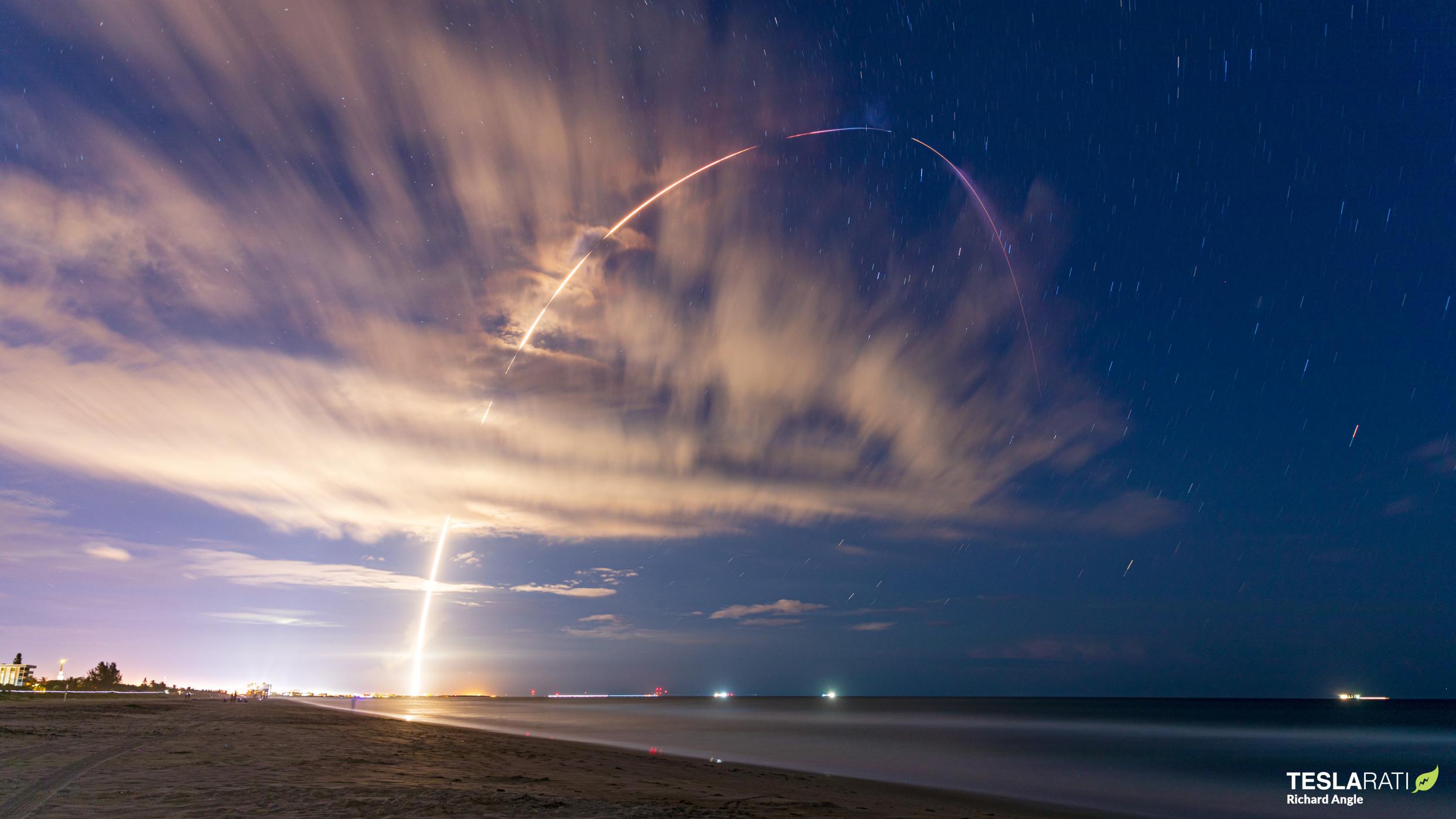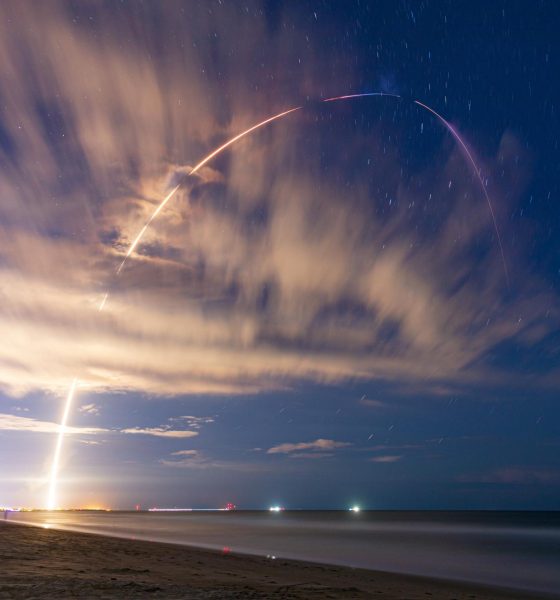SpaceX has completed its 60th operational Starlink satellite launch after a rare string of scrubs.
Flying for the 6th time just 66 days after its 5th launch, Falcon 9 booster B1067 lifted off with 54 Starlink satellites on SpaceX’s Starlink 4-34 mission at 8:18 pm EDT, Sunday, September 18th. Five days prior, after unknown issues triggered a delay from a planned September 11th launch attempt, SpaceX attempted to launch the mission for the first time on September 13th.
About an hour before liftoff, lightning conditions forced the company to call off the attempt. On September 14th, also about an hour before liftoff, weather forced SpaceX to call off the second attempt. On September 15th, the third attempt was aborted (by weather) just 29 seconds before liftoff, followed by a fourth weather-related scrub about a minute before liftoff on September 16th. Only after a fifth attempt on September 17th was preempted by a delay to September 18th did SpaceX finally find a gap between Florida’s summer weather.
With dozens of Starlink launches beginning to blur together and SpaceX’s Falcon 9 continuing a relentless and potentially record-breaking streak of successes at a pace that could soon make it the fastest launching rocket in history, it’s hard to be surprised that Starlink 4-34 was completed without issue. Falcon 9 B1067 ascended under power for about three minutes, sent the rest of the rocket on the way to orbit, coasted into space, and returned to Earth with SpaceX’s 68th consecutively successful booster landing.
Falcon 9’s underappreciated upper stage continued into an orbit around 300 kilometers (~190 mi) up, spun itself up end over end, and deployed a 16.7-ton (~36,900 lb) stack of 54 Starlink V1.5 satellites all at once. Following the quick deployment, the rocket’s pair of reusable fairing halves were likely still 10 or 20 minutes away from touching down on the Atlantic Ocean under their GPS-guided parafoils, where they will eventually be scooped out of the water for future flights.
Starlink 4-34 was SpaceX’s 42nd launch of 2022, maintaining an average of one launch every 6.2 days since the year began. It leaves more than 3000 working Starlink satellites in Earth orbit, likely meaning that a majority of all working satellites are owned and operated by SpaceX less than three full years after the company began operational launches.
Up next, Next Spaceflight and Spaceflight Now report that SpaceX has two more Starlink launches (4-35 and 4-36) tentatively scheduled before the end of September. As of September 15th, both reported that those missions were working towards launches on September 19th and September 26th – nothing unusual for SpaceX in 2022.
What was unusual, however, was both unofficial manifests’ agreement that SpaceX intended to use the same pad – Cape Canaveral Space Force Station’s LC-40 – to launch Starlink 4-34, 4-35, and 4-36. Even assuming that those schedules were predicated upon Starlink 4-34 launching on September 13th, before all of its weather delays, SpaceX would have had to break LC-40’s 7.7-day turnaround record by around ~25% and complete a second launch just seven days after that.
Starlink 4-34’s delays have thrown that plan into question, but the fact that SpaceX thought it was possible in the first place suggests that the company has plans to squeeze even more performance out of LC-40 – already its most important pad from the perspective of launch cadence. Launch photographer Ben Cooper now reports that Starlink 4-36 could launch in late September or October. If it slips into October, SpaceX has a rapid-fire pair of customer satellite launches scheduled on October 5th and 13th that will probably take precedent over any internal Starlink mission.
With only 16 days left before LC-40’s next commercial launch and NASA’s Crew-5 launch taking over SpaceX’s other East Coast pad until October 3rd, SpaceX would have to launch Starlink 4-35 and 4-36 just four or five days apart (and one just 4-5 days after Starlink 4-34) to avoid delaying one of the Starlink missions well into October, avoid unnecessarily delaying commercial launches for paying customers, and ensure that those customers don’t have abruptly agree to be commercial guinea pigs for extra quick LC-40 turnarounds.
Starlink 4-35 is now tentatively scheduled for September 23rd, making a Starlink 4-36 delay more likely but not fully ruling out a launch attempt before the end of the month.

News
Tesla FSD fleet is nearing 7 billion total miles, including 2.5 billion city miles
As can be seen on Tesla’s official FSD webpage, vehicles equipped with the system have now navigated over 6.99 billion miles.

Tesla’s Full Self-Driving (Supervised) fleet is closing in on almost 7 billion total miles driven, as per data posted by the company on its official FSD webpage.
These figures hint at the massive scale of data fueling Tesla’s rapid FSD improvements, which have been quite notable as of late.
FSD mileage milestones
As can be seen on Tesla’s official FSD webpage, vehicles equipped with the system have now navigated over 6.99 billion miles. Tesla owner and avid FSD tester Whole Mars Catalog also shared a screenshot indicating that from the nearly 7 billion miles traveled by the FSD fleet, more than 2.5 billion miles were driven inside cities.
City miles are particularly valuable for complex urban scenarios like unprotected turns, pedestrian interactions, and traffic lights. This is also the difference-maker for FSD, as only complex solutions, such as Waymo’s self-driving taxis, operate similarly on inner-city streets. And even then, incidents such as the San Francisco blackouts have proven challenging for sensor-rich vehicles like Waymos.
Tesla’s data edge
Tesla has a number of advantages in the autonomous vehicle sector, one of which is the size of its fleet and the number of vehicles training FSD on real-world roads. Tesla’s nearly 7 billion FSD miles then allow the company to roll out updates that make its vehicles behave like they are being driven by experienced drivers, even if they are operating on their own.
So notable are Tesla’s improvements to FSD that NVIDIA Director of Robotics Jim Fan, after experiencing FSD v14, noted that the system is the first AI that passes what he described as a “Physical Turing Test.”
“Despite knowing exactly how robot learning works, I still find it magical watching the steering wheel turn by itself. First it feels surreal, next it becomes routine. Then, like the smartphone, taking it away actively hurts. This is how humanity gets rewired and glued to god-like technologies,” Fan wrote in a post on X.
News
Tesla starts showing how FSD will change lives in Europe
Local officials tested the system on narrow country roads and were impressed by FSD’s smooth, human-like driving, with some calling the service a game-changer for everyday life in areas that are far from urban centers.

Tesla has launched Europe’s first public shuttle service using Full Self-Driving (Supervised) in the rural Eifelkreis Bitburg-Prüm region of Germany, demonstrating how the technology can restore independence and mobility for people who struggle with limited transport options.
Local officials tested the system on narrow country roads and were impressed by FSD’s smooth, human-like driving, with some calling the service a game-changer for everyday life in areas that are far from urban centers.
Officials see real impact on rural residents
Arzfeld Mayor Johannes Kuhl and District Administrator Andreas Kruppert personally tested the Tesla shuttle service. This allowed them to see just how well FSD navigated winding lanes and rural roads confidently. Kruppert said, “Autonomous driving sounds like science fiction to many, but we simply see here that it works totally well in rural regions too.” Kuhl, for his part, also noted that FSD “feels like a very experienced driver.”
The pilot complements the area’s “Citizen Bus” program, which provides on-demand rides for elderly residents who can no longer drive themselves. Tesla Europe shared a video of a demonstration of the service, highlighting how FSD gives people their freedom back, even in places where public transport is not as prevalent.
What the Ministry for Economic Affairs and Transport says
Rhineland-Palatinate’s Minister Daniela Schmitt supported the project, praising the collaboration that made this “first of its kind in Europe” possible. As per the ministry, the rural rollout for the service shows FSD’s potential beyond major cities, and it delivers tangible benefits like grocery runs, doctor visits, and social connections for isolated residents.
“Reliable and flexible mobility is especially vital in rural areas. With the launch of a shuttle service using self-driving vehicles (FSD supervised) by Tesla in the Eifelkreis Bitburg-Prüm, an innovative pilot project is now getting underway that complements local community bus services. It is the first project of its kind in Europe.
“The result is a real gain for rural mobility: greater accessibility, more flexibility and tangible benefits for everyday life. A strong signal for innovation, cooperation and future-oriented mobility beyond urban centers,” the ministry wrote in a LinkedIn post.
News
Tesla China quietly posts Robotaxi-related job listing
Tesla China is currently seeking a Low Voltage Electrical Engineer to work on circuit board design for the company’s autonomous vehicles.

Tesla has posted a new job listing in Shanghai explicitly tied to its Robotaxi program, fueling speculation that the company is preparing to launch its dedicated autonomous ride-hailing service in China.
As noted in the listing, Tesla China is currently seeking a Low Voltage Electrical Engineer to work on circuit board design for the company’s autonomous vehicles.
Robotaxi-specific role
The listing, which was shared on social media platform X by industry watcher @tslaming, suggested that Tesla China is looking to fill the role urgently. The job listing itself specifically mentions that the person hired for the role will be working on the Low Voltage Hardware team, which would design the circuit boards that would serve as the nervous system of the Robotaxi.
Key tasks for the role, as indicated in the job listing, include collaboration with PCB layout, firmware, mechanical, program management, and validation teams, among other responsibilities. The role is based in Shanghai.
China Robotaxi launch
China represents a massive potential market for robotaxis, with its dense urban centers and supportive policies in select cities. Tesla has limited permission to roll out FSD in the country, though despite this, its vehicles have been hailed as among the best in the market when it comes to autonomous features. So far, at least, it appears that China supports Tesla’s FSD and Robotaxi rollout.
This was hinted at in November, when Tesla brought the Cybercab to the 8th China International Import Expo (CIIE) in Shanghai, marking the first time that the autonomous two-seater was brought to the Asia-Pacific region. The vehicle, despite not having a release date in China, received a significant amount of interest among the event’s attendees.










